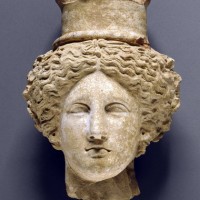-
Cleveland Museum of Art Cancels Planned Exhibition of Sicilian Art: A Cautionary Tale About Art Loans
07/15/2013
 A few weeks ago, we discussed tensions between Sicilian cultural officials and two American museums regarding an exhibition of ancient artworks and artifacts from Sicily. The works have been on display at the Getty Villa in Malibu, California, and they were scheduled to travel to the Cleveland Museum of Art in September—until Sicilian officials decided that the ongoing loan of some of the most prominent works was damaging Sicily’s tourism trade. The complaints threw a wrench into the planned exhibits, particularly as there was no signed contract governing the terms of the overseas loans of artworks from Sicily to the two museums.
A few weeks ago, we discussed tensions between Sicilian cultural officials and two American museums regarding an exhibition of ancient artworks and artifacts from Sicily. The works have been on display at the Getty Villa in Malibu, California, and they were scheduled to travel to the Cleveland Museum of Art in September—until Sicilian officials decided that the ongoing loan of some of the most prominent works was damaging Sicily’s tourism trade. The complaints threw a wrench into the planned exhibits, particularly as there was no signed contract governing the terms of the overseas loans of artworks from Sicily to the two museums.
Sadly, the parties seem to have failed to reach a compromise; this week, The Plain Dealer and the New York Times both report that the Cleveland Museum of Art has canceled its planned exhibit. The museum’s director, David Franklin, expressed disappointment, but explained that, although the United States embassy in Rome and the Italian embassy in Washington tried to help mediate the dispute, the Sicilian government continued to insist that the works should be returned to their homeland (Sicily governs its cultural affairs with significant independence from Italy’s central government). Franklin also noted that the conflict may have been influenced by Italy’s ongoing economic recession, which has made tourist dollars even more important.
The cancellation raises concerns about whether countries with significant archaeological treasures are becoming less willing to send those works abroad. Sicily is reportedly considering charging high loan fees to borrow works for exhibitions in the future; higher costs could put these works out of reach for some nonprofit organizations.
As for the immediate fallout, news coverage only hints at the repercussions for the American museums. Franklin stated that, while he had been involved in discussions between the Getty and diplomatic officials regarding the loans, the Getty had taken the lead role in those talks. Unfortunately, now it is the Cleveland Museum of Art that will suffer the loss of this major exhibition, while in the midst of a major renovation and expansion effort. The Cleveland Museum will need to scramble to fill the new gap on its calendar and the temporary galleries that had been set aside for the Sicilian works. Meanwhile, although the Getty and the Cleveland museum had originally planned to share expenses related to the exhibition, the Getty has announced that it will bear all the costs. A spokesman for the Getty pointed out that the Getty had already expended funds for “very substantial conservation work” on some of the Sicilian artifacts and invested significant resources in organizing the show; now, “the Getty alone will have to bear the full exhibition costs, which will take funds away from future collaborations with Sicily.”
Franklin also acknowledged that it is not unusual for his museum to arrange international loans without first putting a contract in place. He told the Plain Dealer:The works usually travel before there is a formal agreement. . . . That comes at the end of the process. It’s the way things are done; it’s a very trusting and very elegant way of doing business. . . . This was a deep surprise and goes contrary to the way exhibitions travel in the world today. But of course it’s a wake-up call to all of us to rethink how we do international exhibitions.
He predicted that, in the future, they would formalize agreements “earlier in the process, probably through a memorandum of understanding, not necessarily a formal contract… A museum like ours can’t risk this to have happen ever again.” The art community would do well to consider this situation a cautionary tale about the importance of sound contracting practices in advance of any plans to loan or borrow artworks; this “very trusting and very elegant way of doing business” without comprehensive legal agreements is simply not enough to protect the significant interests at stake.
Art Law Blog
